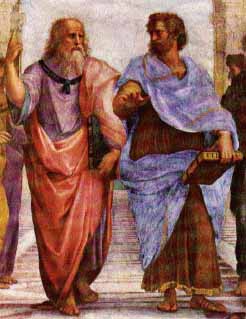Aristotle (384-322 B.C.E.)
Aristotle was born in Stagira in north Greece, the son of Nichomachus, the court physician to the Macedonian royal family. He was trained first in medicine, and then in 367 he was sent to Athens to study philosophy with Plato. He stayed at Plato's Academy until about 347 -- the picture at the top of this page, taken from Raphael's fresco The School of Athens, shows Aristotle and Plato (Aristotle is on the. right). Though a brilliant pupil, Aristotle opposed some of Plato's teachings, and when Plato died, Aristotle was not appointed head of the Academy. After leaving Athens, Aristotle spent some time traveling, and possibly studying biology, in Asia Minor (now Turkey) and its islands. He returned to Macedonia in 338 to tutor Alexander the Great; after Alexander conquered Athens, Aristotle returned to Athens and set up a school of his own, known as the Lyceum. After Alexander's death, Athens rebelled against Macedonian rule, and Aristotle's political situation became precarious. To avoid being put to death, he fled to the island of Euboea, where he died soon after.
Aristotle is said to have written 150 philosophical treatises. The 30 that survive touch on an enormous range of philosophical problems, from biology and physics to morals to aesthetics to politics. Many, however, are thought to be "lecture notes" instead of complete, polished treatises, and a few may not be the work of Aristotle but of members of his school.
Aristotle's thoughts on earth sciences can be found in his treatise Meteorology -- the word today means the study of weather, but Aristotle used the word in a much broader sense, covering, as he put it, "all the affections we may call common to air and water, and the kinds and parts of the earth and the affections of its parts." Here he discusses the nature of the earth and the oceans. He worked out the hydrologic cycle: "Now the sun, moving as it does, sets up processes of change and becoming and decay, and by its agency the finest and sweetest water is every day carried up and is dissolved into vapour and rises to the upper region, where it is condensed again by the cold and so returns to the earth." He discusses winds, earthquakes (which he thought were caused by underground winds), thunder, lightning, rainbows, and meteors, comets, and the Milky Way (which he thought were atmospheric phenomena). His model of Earth history contains some remarkably modern-sounding ideas:
The same parts of the earth are not always moist or dry, but they change according as rivers come into existence and dry up. And so the relation of land to sea changes too and a place does not always remain land or sea throughout all time, but where there was dry land there comes to be sea, and where there is now sea, there one day comes to be dry land. But we must suppose these changes to follow some order and cycle. The principle and cause of these changes is that the interior of the earth grows and decays, like the bodies of plants and animals. . . .
But the whole vital process of the earth takes place so gradually and in periods of time which are so immense compared with the length of our life, that these changes are not observed, and before their course can be recorded from beginning to end whole nations perish and are destroyed.

No comments:
Post a Comment